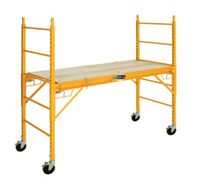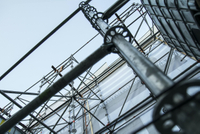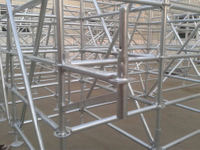Content Menu
● Structural Components Contributing to Stability
>> Frames
>> Cross Braces
>> Base Plates and Adjustable Jacks
>> Guardrails and Toe Boards
● How Frame and Brace Scaffolding Performs in Various Weather Conditions
>> Wind
>> Rain and Wet Conditions
>> Snow and Ice
>> Extreme Temperatures
● Best Practices for Ensuring Safety and Stability in All Weather
>> Proper Foundation and Leveling
>> Secure Ties and Bracing
>> Regular Inspections
>> Load Management
>> Use of Guardrails and Safety Equipment
● Regulatory Standards and Guidelines
● Common Causes of Scaffold Instability and How to Avoid Them
● Conclusion
● FAQ
>> 1. How does cross bracing improve the stability of frame and brace scaffolding?
>> 2. What are the requirements for tying scaffolding to a building?
>> 3. Can frame and brace scaffolding be used on uneven ground?
>> 4. What safety features should be included on frame and brace scaffolding?
>> 5. How often should scaffolding be inspected in adverse weather?
Frame and brace scaffolding consists of prefabricated vertical frames connected by horizontal ledgers and diagonal braces. The frames form the vertical structure, while cross braces provide lateral stability. This system is favored for its rapid assembly and adaptability to different heights and configurations.The interlocking design ensures rigidity and stability, even when subjected to external forces such as wind or vibration[1].
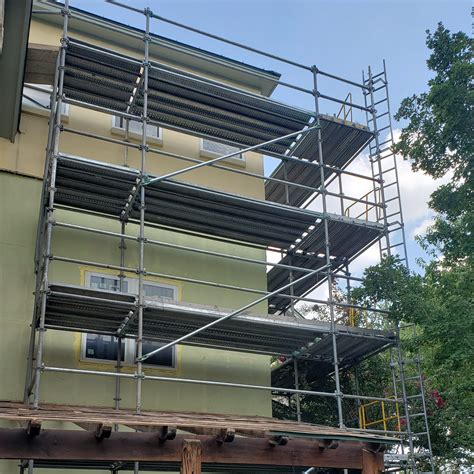
Structural Components Contributing to Stability
Frames
Vertical steel or aluminum frames form the backbone of the scaffold. They typically come in standard heights (e.g., 6 ft or 2 m) and widths (e.g., 5 ft or 1.5 m). The frames are designed to bear vertical loads and transfer them safely to the ground through base plates or adjustable jacks[5].
Cross Braces
Diagonal cross braces connect the frames, creating an "X" pattern that resists lateral forces. These braces prevent racking (sideways sway) and provide essential rigidity to the scaffold structure[3][7].
Base Plates and Adjustable Jacks
Base plates distribute the scaffold load over a larger area, preventing sinking or tilting on soft ground. Adjustable jacks allow leveling on uneven surfaces, ensuring the scaffold remains plumb and stable[2][5].
Guardrails and Toe Boards
Guardrails prevent falls from the platform edges, while toe boards stop tools or materials from falling off, enhancing worker safety[7][9].
How Frame and Brace Scaffolding Performs in Various Weather Conditions
Wind
Wind is one of the most significant factors affecting scaffold stability. The open design of frame and brace scaffolding allows wind to pass through, reducing pressure. However, strong gusts can still cause sway or tipping if not properly secured.
- Tie-Ins: Scaffolds taller than four times their minimum base dimension must be tied to the building at regular intervals to prevent tipping[4].
- Additional Bracing: Extra diagonal or horizontal braces can be added to increase rigidity during windy conditions[4].
- Wind Screens: When scaffolds are enclosed with mesh or tarps, wind loads increase significantly, necessitating more frequent ties and robust bracing[4].
Rain and Wet Conditions
Wet weather can soften ground surfaces, affecting base plate stability. Proper use of sole boards or timber mats under base plates is essential to distribute loads and prevent sinking or tilting.
- Slip Hazards: Wet platforms can become slippery; anti-slip decking or mats should be used.
- Corrosion Protection: Components should be galvanized or painted to resist rust from moisture exposure[1].
Snow and Ice
Snow accumulation adds extra weight and can cause slipping hazards.
- Load Considerations: Snow load must be factored into the scaffold's total load capacity.
- Regular Clearing: Platforms and braces should be cleared of snow and ice frequently to maintain safety.
Extreme Temperatures
Both hot and cold temperatures can affect scaffold materials.
- Cold Weather: Steel can become brittle; inspections should focus on cracks or damage.
- Heat: Expansion of metal parts can loosen connections; regular checks are necessary.
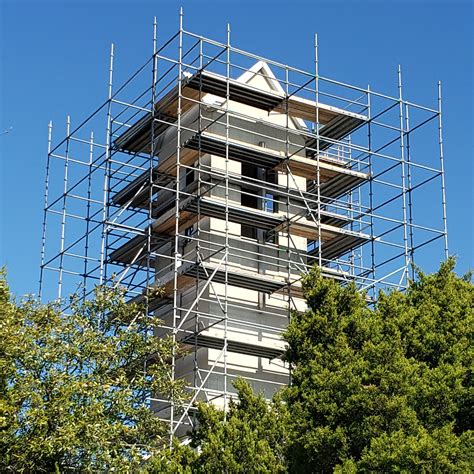
Best Practices for Ensuring Safety and Stability in All Weather
Proper Foundation and Leveling
- Use base plates and sole boards on firm ground.
- Adjust jacks to level the scaffold precisely.
- Avoid erecting scaffolds on soft or unstable soil without proper support[2].
Secure Ties and Bracing
- Tie scaffolds to adjacent structures at intervals specified by regulations (e.g., every 26 ft vertically and 30 ft horizontally)[4].
- Install all required cross braces and add extra bracing in adverse weather[3][4].
Regular Inspections
- Inspect scaffolding daily and after severe weather events.
- Check for loose connections, damaged braces, or shifted base plates[9].
- Remove damaged components immediately.
Load Management
- Do not overload scaffolds; adhere to manufacturer load limits.
- Distribute materials evenly to prevent unbalanced loads[9].
Use of Guardrails and Safety Equipment
- Always install guardrails and toe boards.
- Use personal fall arrest systems where required.
- Provide safe access ladders or stairways, not climbing cross braces[4][10].
Regulatory Standards and Guidelines
- OSHA 29 CFR 1926.451: Specifies requirements for supported scaffolds, including frame scaffolding, base plates, bracing, and tie-ins[2].
- ANSI/SSFI SC100-5/16: Provides safety requirements for scaffold systems.
- EN 12810: European standard for facade scaffolding including frame and brace systems.
- Compliance with these standards is mandatory to ensure scaffold safety in all conditions.
Common Causes of Scaffold Instability and How to Avoid Them
| Cause | Prevention |
| Undermined Base | Use base plates and sole boards; avoid digging near scaffold legs. |
| Missing or Loose Braces | Install all required braces; check and tighten regularly. |
| Lack of Ties | Tie scaffold to structure per regulations. |
| Overloading | Adhere to load limits; distribute loads evenly. |
| Damaged Components | Inspect and replace damaged parts immediately. |
| Weather Neglect | Secure scaffold before storms; clear snow and debris regularly. |
Conclusion
Frame and brace scaffolding systems, when properly assembled and maintained, offer excellent safety and stability even in challenging weather conditions. Their interlocking design, combined with adequate bracing, secure tie-ins, and stable foundations, ensures that the scaffold remains rigid and safe for workers. Adhering to safety standards, conducting regular inspections, and taking weather conditions into account are essential for preventing accidents and scaffold failures. With these precautions, frame and brace scaffolding remains a reliable and efficient solution for construction and maintenance projects year-round.
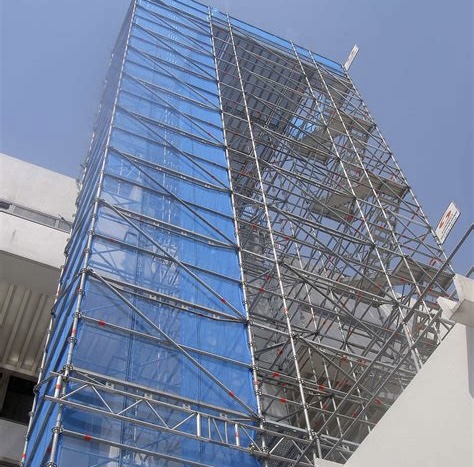
FAQ
1. How does cross bracing improve the stability of frame and brace scaffolding?
Cross bracing provides lateral support, preventing sideways movement and racking of the scaffold structure, which is crucial for stability under load and wind pressure[3].
2. What are the requirements for tying scaffolding to a building?
Scaffolds taller than four times their base width must be tied to the building at intervals not exceeding 26 feet vertically and 30 feet horizontally to prevent tipping[4].
3. Can frame and brace scaffolding be used on uneven ground?
Yes, with the use of adjustable base jacks and sole boards, scaffolding can be leveled and stabilized on uneven surfaces[2].
4. What safety features should be included on frame and brace scaffolding?
Guardrails, toe boards, secure platforms, locking pins, and safe access ladders or stairways are essential to ensure worker safety[7][9].
5. How often should scaffolding be inspected in adverse weather?
Scaffolding should be inspected daily during use and immediately after severe weather events such as storms, heavy rain, or snow to ensure continued safety[9].












